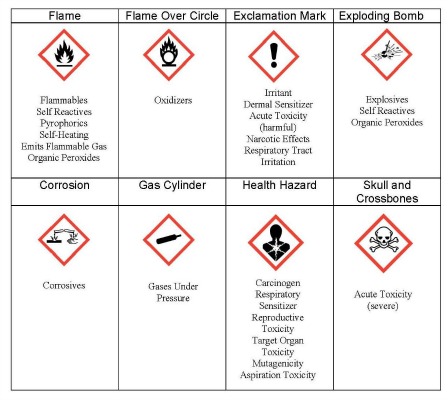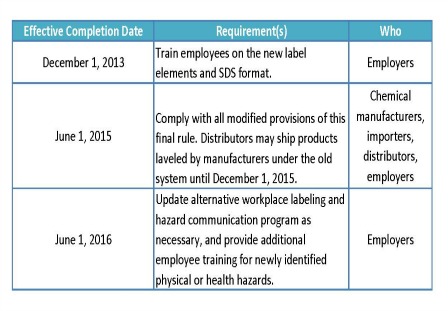Countertops Magazine Archive
Building a Safety Program for Your Business
Building a Safety Program for Your Business
Surface Fabricators need safety programs to protect their workers and to satisfy OSHA requirements. Any accident or citation can cost your business in fines, workers compensation, damaged equipment and materials, medical costs, morale and negative press. Review these 10 tips to see if your fabrication shop is OSHA compliant.
1. Perform a Hazard Assessment
Every safety program begins with hazard assessment. A workplace hazard is any condition or procedure that has the potential to hurt someone. A hazard evaluation looks for the hazards that may exist at your facility so that they can be managed before accidents occur. Even if there is no specific OSHA standard, OSHA can still fine you under the “General Duty Clause” whether or not the hazard results in an accident or illness.
2. Eliminate Unsafe Conditions and Procedures
The goal of a safety program is to have zero injuries or illnesses caused by exposures in the workplace. OSHA has a specific hierarchy that should be followed as a “filter down” technique to manage occupational hazards. After thoroughly assessing your shop for hazards, eliminate all unsafe conditions or procedures that are not essential to the work to be performed. Next try to substitute systems with less hazardous materials/procedures whenever possible.
3. Implement Engineering Controls
After eliminating as many unsafe conditions as possible, implement engineering controls to eliminate or reduce remaining hazards. Examples of engineering controls include the redesign of work areas, enclosing dangerous machine parts and adding ventilation and dust management systems.
4. Establish Safe Work Practices
Work practices are the methods and procedures used to perform tasks. Develop safe work practices for all tasks that involve hazards. The more complicated the task, the greater the need for established safe procedures. Procedures should include any administrative controls, such as job rotation, to reduce ergonomic issues. OSHA requires that certain types of procedures, such as lockout/tagout for equipment maintenance, be in writing.
5. Personal Protective Equipment (PPE)
When exposure to hazards cannot be completely eliminated through engineering controls and safe work practices, you must provide adequate protective clothing and equipment to each employee. Typical PPE needed for surface fabrication includes steel toe boots, work gloves, safety glasses, dust masks and hearing protection.
6. Emergency and First Aid Plan
You must have an emergency and first aid plan in case an accident or exposure to corrosive or other chemicals occurs. This may include CPR training, quick drench showers and eyewash stations.
7. Develop and Maintain Needed Safety Programs
Injury risk factors present in the surface fabrication industry include manual lifting, use of hand tools and machinery, noise exposure, heat and sharp edge exposure, working in awkward postures, exposure to vibration and chemical and dust exposure. These factors will vary in each business. Almost every surface fabrication shop will require safety programs for: safe usage and storage of chemicals; equipment safety, including machine guarding; air tools; safe usage and storage of flammable liquids; lockout/tagout procedures for equipment maintenance; electrical safety and electrical cords at construction sites; noise exposure; thermoforming; silica; bloodborne pathogens; programs for slips, trips and falls; safe storage of heavy raw materials; and ergonomics.
8. Train Employees
Training is the backbone of any safety program. Each employee must be trained on what hazards exist, and your plan to protect them at their job. OSHA has specific requirements about the content and frequency of training that is required for each type of hazard.
9. Cultivate a Safety Culture
Establish a safety culture for your business, where employees understand that safety is EVERYONE’S job. Each employee needs to understand how to prevent accidents in his or her work area, what to do if something seems dangerous and who to talk to about safety concerns.
10. Keep your Eye on the Prize
Remember that safety programs not only protect your employees, but are also key to a successful business.
Keeping current with any changes in OSHA regulations is essential for effective safety programs. For example, OSHA recently revised the Hazard Communication Standard to align with the Globally Harmonized System of Classification and Labeling of Chemicals (GHS). This requires you to train your employees by December 1 of this year.
Hazard Communication and the Global Harmonization System
On March 26th, 2012, OSHA revised the Hazard Communication Standard to align with the GHS. GHS is an internationally agreed upon system that will replace the various classification and labeling standards used in different countries. The old Hazard Communication Standard allowed chemical manufacturers and importers to convey hazard information on labels and material safety data sheets in whatever format they chose. The new standard specifies hazard communication rules for both labeling and safety data sheets (SDS).
How Hazard Communication Works
Chemical Manufacturers and Importers
* Classify the hazards of chemicals they produce or import.
* Prepare labels and safety data sheets based on the classifications.
Employers
* Receive labeled containers and safety data sheets.
* Implement the Hazard Communication Program.
Major changes to the Hazard Communication Standard include:
Safety Data Sheets: Material Safety Data sheets are now called Safety Data Sheets and are strictly formatted. The new format requires 16 specific sections, ensuring consistency in presentation of important protection information. Employees must be trained on the new standardized format and the type of information they will find in each section.
Labels: New labels will include a signal word, pictogram, hazard statement and precautionary statements for each hazard class. Employees must be trained on the type of information they will see on the new labels and how this information applies to them.
-
Figure 1 – A new system of labels that include pictograms has been specified by OSHA. Employers must teach their employees to recognize these pictograms and what they mean.
Pictograms
The new Hazard Communication Standard requires pictograms on all labels. Pictograms alert users to the chemical hazards to which they may be exposed. The pictogram on the label is determined by the chemical hazard classification. Employers must teach their employees to recognize these pictograms and what they mean (see Figure 1).
-
Figure 2 – OSHA has set deadlines for the changes to the required safety systems, the first of which is Dec. 31, 2013.
Until the compliance deadlines, both the current format for labels and for material safety data sheets and the new SDS format may be provided by manufacturers that provide chemicals used in your workplace. It is important to begin transitioning your employee training so that it includes both previous and new label and SDS formats by December 1 of 2013 (see Figure 2).
About the Author
Shannon DeCamp is client services manager with Techne Train Inc., a provider of information on OSHA and the surface fabrication industry. More information is available by calling Techne Train at (800) 852-8314 or visiting www.technetrainonline.com.
SEE ALSO: ISFA’s Federal OSHA Compliance Manuals for the Surface Fabrication Industry
|


